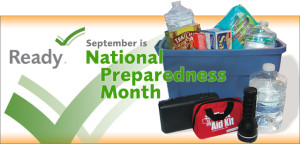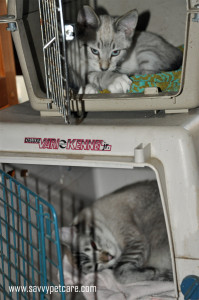Are you prepared for a natural disaster or other emergency? In a Citizen Corps National Survey taken in  2009, less than 50% of Americans surveyed reported having a household emergency plan. This month is the 10th annual National Preparedness Month, sponsored by the Federal Emergency Management Agency (FEMA) in the US Department of Homeland Security. September was chosen as National Preparedness Month, as the tragedies of September 11th, 2001 highlighted to the nation the importance of being prepared.
2009, less than 50% of Americans surveyed reported having a household emergency plan. This month is the 10th annual National Preparedness Month, sponsored by the Federal Emergency Management Agency (FEMA) in the US Department of Homeland Security. September was chosen as National Preparedness Month, as the tragedies of September 11th, 2001 highlighted to the nation the importance of being prepared.
Simple Steps for Disaster Preparedness
Natural disasters or other emergencies can strike at any time without warning but you can take simple steps to prepare for emergencies in your home. FEMA has identified four major steps to being prepared:
- Be informed
- Make a plan
- Build a kit
- Get involved
Building a Kit
Include your Pets in your Disaster Preparedness Plan
When you are making your disaster preparedness plan and building your kit, remember to include your pets. #disasterpreparedness #includeyourpets Share on XWhen you are making your plan and building your kit, remember to include your pets. Leaving them behind in a disaster puts them and others at risk.
Having proper identification on your pet is important every day but essential in a disaster. You may have a carrier to take pets to the vet or groomer but do you have one for each pet? Be sure each crate has identification on it. Familiarize your pets with the crates before they are needed. Know where you will go when you evacuate. Pets may not be allowed in human shelters so know where pet friendly hotels are or make arrangements to stay with a friend or relative outside of the disaster area.
Disaster Supplies for Pets
- Food (in airtight waterproof containers or cans) and water for at least 2 weeks for each pet
- Food and water bowls and a manual can opener
- For cats: litter box and litter
- For dogs: plastic bags for poop
- Clean-up items for bathroom accidents (paper towels, plastic trash bags, bleach-containing cleaning agent)
- Medications for at least 2 weeks, along with any treats used to give the medications and pharmacy contact for refills

- Medical records
- Rabies vaccination certificate
- Current vaccination record
- If your pet has a microchip, a record of the microchip number
- Prescription for medication(s)
- For cats, most recent FeLV/FIV test result or vaccination date
- Summary of pertinent medical history; ask your veterinarian for a copy
- Sturdy leashes or harnesses
- Carrier or cage that is large enough for your pet to stand comfortably and turn around; towels or blankets
- Pet toys and bed (familiar items to help the pet[s] feel more comfortable).
- A handout containing identification
 information (in the event you get separated from your pet)
information (in the event you get separated from your pet)
- Current photo of pet
- Pet’s descriptive features (age, sex, neutered/non-neutered status, color(s), and approximate weight)
- Microchip number
- Owner contact information (cell phone, work phone, home phone)
- Contact information of a close relative or friend,
- A handout with boarding instructions,
 such as feeding schedule, medications, and any known allergies and behavior problems
such as feeding schedule, medications, and any known allergies and behavior problems - Documents, medications, and food should be stored in waterproof containers
More Information for Pet Owners
- CDC Protect your Pets in an Emergency
- CDC Emergency Preparedness and YouCDC Fact sheet: Protect yourself from animal and insect-related hazards after a disaster
- Saving the Whole Family guide to disaster preparedness from the American Veterinary Medical Association
 [PDF – 378KB]
[PDF – 378KB]
- Federal Emergency Management Agency: Considerations for caring for animals during a disaster

- Humane Society of the United States: Making a disaster plan for pets

- United States Department of Agriculture: Animal Emergency and Disaster Planning Information
 (includes farm animals)
(includes farm animals) - Federal Emergency Management Agency: Evacuation routes

- Louisiana State University College of Veterinary Medicine: Manual for Animal Shelters during a Disaster

- READY.GOV Prepare for Emergencies Now: Information for Pet Owners
 [PDF – 283KB]
[PDF – 283KB]
























Pingback: Survive the Storm -- Be Prepared for a Natural Disaster | Gold Country Cowgirl
Pingback: 5 Things to do Before Disaster Strikes -- Cat Disaster Preparedness